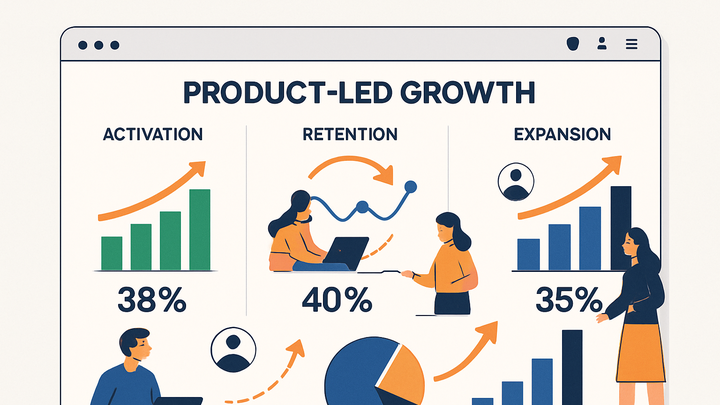Published on 2025-06-22T04:28:57Z
What is Product-Led Growth (PLG)? Examples and Analytics
Product-Led Growth (PLG) is a go-to-market strategy that empowers the product itself to drive user acquisition, activation, retention, and expansion. Rather than relying primarily on sales-led or marketing-led motions, PLG focuses on delivering immediate value through self-service onboarding, freemium offerings, and in-app engagement that encourage users to convert organically.
This approach reduces customer acquisition costs, scales through product virality, and fosters a data-driven culture of continuous improvement. Analytics tools like PlainSignal and Google Analytics 4 (GA4) are essential to measure key PLG metrics such as activation rate, retention rate, churn, and expansion revenue.
For example, to integrate PlainSignal’s cookie-free analytics, include the following snippet in your HTML:
<link rel="preconnect" href="//eu.plainsignal.com/" crossorigin />
<script defer data-do="yourwebsitedomain.com" data-id="0GQV1xmtzQQ" data-api="//eu.plainsignal.com" src="//cdn.plainsignal.com/plainsignal-min.js"></script>
Plg (product-led growth)
PLG is a SaaS growth strategy driven by product usage, self-service onboarding, and analytics to fuel acquisition and expansion.
Understanding Product-Led Growth
An overview of PLG, how it shifts acquisition and retention by letting the product demonstrate value. This section introduces the concept and why it’s transformative for SaaS businesses.
-
Definition of plg
PLG is a go-to-market strategy where the product itself drives user acquisition, retention, and expansion without heavy reliance on sales-led outreach.
-
Benefits of plg
Key advantages include lower customer acquisition costs, scalable growth through product virality, and improved user engagement by delivering immediate value.
-
Examples in industry
Companies like Slack, Dropbox, and Zoom exemplify PLG by offering freemium tiers, self-service onboarding, and in-app engagement features that convert users into paying customers.
Core Principles and Components
This section delves into the fundamental elements that underpin a successful PLG strategy, including freemium models, user onboarding, and data-driven product improvements.
-
Freemium and free trials
Offering a free tier or trial removes barriers to entry, allowing users to experience the product’s value before committing financially.
-
Conversion rate optimization
Analyzing activation funnels to maximize the percentage of users who upgrade from free to paid plans.
-
Feature gating
Strategically limiting premium features to encourage upgrades while keeping free users engaged.
-
-
Self-service onboarding
Intuitive product walkthroughs, contextual tips, and in-app tutorials empower users to get started on their own.
-
User activation
Tracking time to first key action, such as sending a message in Slack or uploading a file to Dropbox.
-
-
Data-driven iteration
Continuous improvement of product features based on user behavior data to increase activation, retention, and expansion.
Analytics for PLG: Tracking Growth Metrics
Analytics are at the heart of PLG, as data informs product improvements and growth decisions. This section covers essential metrics and how to implement tracking using tools like PlainSignal and GA4.
-
Key plg metrics
Critical metrics include activation rate, daily active users (DAU), weekly active users (WAU), retention rate, churn rate, and expansion revenue to gauge product-led success.
-
Implementing PlainSignal
PlainSignal provides simple, cookie-free analytics ideal for privacy-focused PLG. Insert the following tracking snippet to start collecting insights:
<link rel="preconnect" href="//eu.plainsignal.com/" crossorigin /> <script defer data-do="yourwebsitedomain.com" data-id="0GQV1xmtzQQ" data-api="//eu.plainsignal.com" src="//cdn.plainsignal.com/plainsignal-min.js"></script> -
Leveraging google analytics 4
GA4’s event-based model captures rich user interactions. Configure custom events for key actions like sign-ups, feature usage, and upgrades to feed your PLG dashboard.
-
Event tracking
Set up conversion events in GA4 to monitor activation and revenue-generating actions.
-
Best Practices for PLG Implementation
Implementing PLG successfully requires aligning teams, optimizing onboarding, and fostering a culture of experimentation. This section outlines best practices to drive product-led initiatives.
-
Optimize onboarding experience
Streamline the initial user flow by reducing friction, offering guided tours, and quickly surfacing core value propositions.
-
Foster cross-functional collaboration
Ensure product, marketing, and customer success teams share analytics insights to iterate on features and messaging cohesively.
-
Run continuous experiments
Adopt an A/B testing framework for product features and onboarding flows to validate hypotheses and improve key PLG metrics over time.
